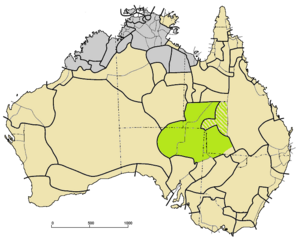Karnic languages facts for kids
Quick facts for kids Karnic |
|
|---|---|
| Geographic distribution: |
Australia |
| Linguistic classification: | Pama–Nyungan
|
| Subdivisions: |
Arabana
Palku
Karna
Ngura (partial)
|
 Karnic languages (green) among other Pama–Nyungan (tan). The four solid-green sections are Arabana (west), Palku (north), Karna (central strip), Ngura (east). The striped area to the east is Kungkari and Birria, which may have been Karnic.
|
|
The Karnic languages are a group of languages spoken by Aboriginal people in parts of Australia. These languages are a branch of the much larger Pama–Nyungan language family, which covers most of mainland Australia.
For a while, some experts thought these languages were separate. However, a linguist named Bowern showed in 2001 that many of them are actually connected. This means they share common roots and patterns, proving they belong to the same language family.
Contents
Main Karnic Language Groups
The Karnic language family is usually divided into several main groups. These groups help us understand how the different languages are related to each other.
Western Karnic Languages
The Arabana language is a key part of the Western Karnic group. It includes the Wangganguru dialect. This language was once thought to be part of the Palku group, but now it's seen as its own distinct Western branch.
Northern Karnic Languages
The Palku group makes up the Northern Karnic languages. Some of the languages in this group are:
- Pitta Pitta
- Wangka-Yutjurru (also known as Wanggamala)
Central Karnic Languages
The Karna group is the main part of the Central Karnic languages. Important languages here include:
- Yandruwandha (which includes the Yawarawarga dialect)
- Mithaka (spoken in the northern area of this group)
- Diyari
- Yarluyandi–Ngamini
Eastern Karnic Languages
The Eastern Karnic group includes languages like:
- Wilson River language (which has dialects like Wangkumara and Bundhamara or Punthamara)
- Ngandangara/Yarumarra
Languages That Are Hard to Classify
Sometimes, it's difficult for linguists to know exactly where a language fits into a family tree. This often happens when there isn't much information or many speakers left for a language.
Fringe Languages
Some languages in the area might be Karnic, but we don't have enough information to be sure. A linguist named Breen mentioned a group of "Karna–Mari fringe" languages. These are scattered between the Karnic and Mari areas. They don't seem to connect much with either group or even with each other.
Possible Karnic Languages
Here are some languages that might be Karnic, but more study is needed:
- Birria (also known as Pirriya or Bidia)
- Pirlatapa
- Kungkari (and possibly Kungatutyi/Gungadidji)
- Karuwali (and possibly Kulumali)
Other names that have been mentioned as possibly Karnic include Karangura, Mayawali, and Nhirrpi.
It's also worth noting the Ngura languages. Some varieties of Ngura are considered Karnic, but others might be part of the Maric language family instead.

